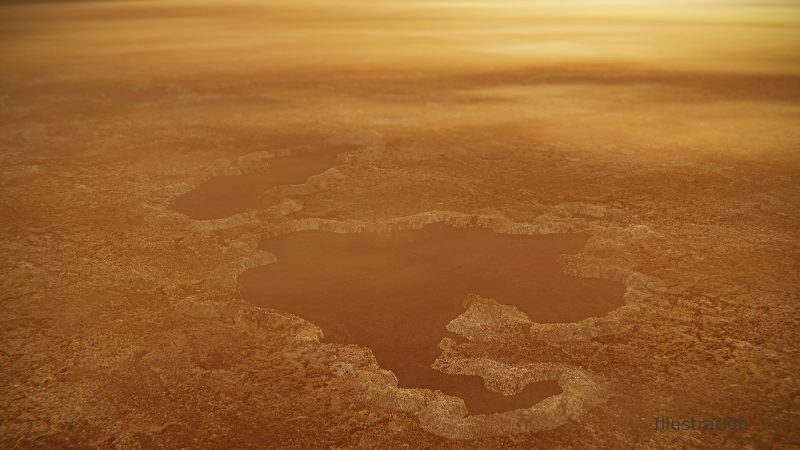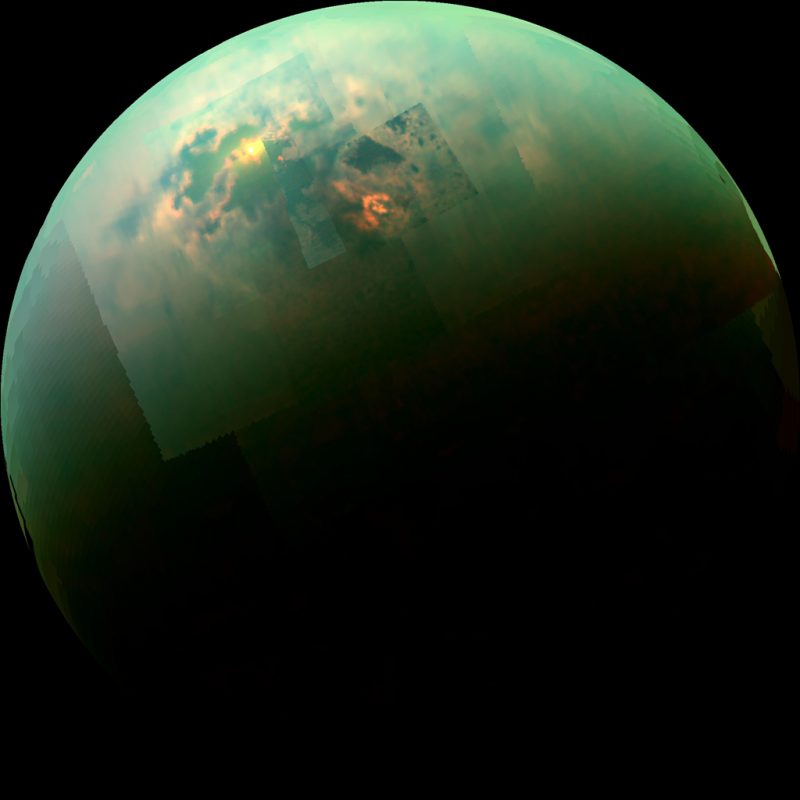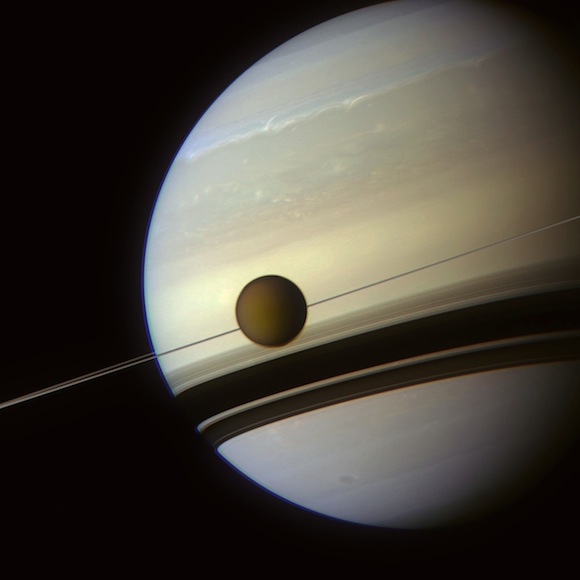

Artist’s concept of a lake at the north pole of Saturn’s large moon Titan. This image illustrates the raised rims and rampart-like features seen by NASA’s Cassini spacecraft around some Titan lakes. Scientists think these features might indicate underground explosions, which carved out the lake beds long ago. Image via NASA/JPL-Caltech.
During its 13 years of scrutinizing Saturn and its moons, the Cassini spacecraft executed dozens of close flybys of the system’s largest moon, Titan. It found that Titan has a cycle much like our water cycle, with a kind of “rain,” although Titan’s rain consists of liquid methane and other organic compounds, not water. Cassini also revealed that Titan’s methane rain has filled basins on its surface, so that this frigid moon is the only world in our solar system, besides Earth, known to have stable surface lakes and seas (albeit not made of water). This week, using radar data from Cassini, scientists published a new scenario to explain why some methane-filled lakes on Titan are surrounded by steep rims that reach hundreds of feet high. The models suggests that explosions of warming nitrogen created the lake basins in the moon’s crust.
The new work was published September 9, 2019, in the peer-reviewed journal Nature Geoscience.
The study suggests that some of Titan’s smaller lakes – just tens of miles across – might have formed when pockets of liquid nitrogen in Titan’s crust warmed, turning into explosive gas that blew out craters, which then filled with liquid methane. Giuseppe Mitri of Italy’s G. d’Annunzio University and Jonathan Lunine of Cornell University in Ithaca, New York, co-authored the new study. They said their theory explains why some of the smaller lakes near Titan’s north pole, like Winnipeg Lacus, appear in radar imaging to have such very steep rims. The rims, their statement said:
… tower above [Titan’s] sea level.
Click here for a large map of Titan’s north polar lakes and seas

Infrared view of seas and lakes in Titan’s northern hemisphere, taken by Cassini in 2014. Sunlight can be seen glinting off the southern part of Titan’s largest sea, Kraken Mare. Image via NASA/JPL-Caltech/University of Arizona/University of Idaho.
The rampart-like rims around some small Titan lakes are hard to explain with other models. Most alternate models of lake formation on Titan show liquid methane dissolving the moon’s bedrock of ice and solid organic compounds, carving reservoirs that fill with the liquid. On Earth, bodies of water that formed similarly, by dissolving surrounding limestone, are known as karst lakes. On Titan, this karstic model might explain some of Titan’s lakes – those with sharp boundaries – but, Mitri and Lunine believe, it does not explain all of them. Mitri commented in a statement:
… We were not finding any explanation that fit with a karstic lake basin. In reality, the morphology was more consistent with an explosion crater, where the rim is formed by the ejected material from the crater interior. It’s totally a different process.
Their statement further explained:
Over the last half-billion or billion years on Titan, methane in its atmosphere has acted as a greenhouse gas, keeping the moon relatively warm – although still cold by Earth standards. Scientists have long believed that the moon has gone through epochs of cooling and warming, as methane is depleted by solar-driven chemistry and then resupplied.
In the colder periods, nitrogen dominated the atmosphere, raining down and cycling through the icy crust to collect in pools just below the surface …
And so, said Jonathan Lunine:
These lakes with steep edges, ramparts and raised rims would be a signpost of periods in Titan’s history when there was liquid nitrogen on the surface and in the crust.
He added that even localized warming would have been enough to turn the liquid nitrogen into vapor, cause it to expand quickly and blow out a crater.
So, it seems, studies based on Cassini spacecraft data keep coming, even though Cassini itself burned up in Saturn’s atmosphere, ending its 13-year orbit around the planet, in 2017. And, scientists say, they don’t expect the mining of Cassini data to end anytime soon. Cassini Project Scientist Linda Spilker of JPL commented:
This is a completely different explanation for the steep rims around those small lakes, which has been a tremendous puzzle. As scientists continue to mine the treasure trove of Cassini data, we’ll keep putting more and more pieces of the puzzle together. Over the next decades, we will come to understand the Saturn system better and better.

Cassini captured this image of Saturn with its large moon, Titan, on August 29, 2012. Image via NASA/JPL-Caltech/SSI. Want to see more images? Try this collection of the most inspiring, beautiful and historic images from Cassini, from Vox.
Bottom line: A new study suggests the high rampart-like rims around some of the smaller lakes on Titan might have been caused by explosions of warming nitrogen.
Source: Possible explosion crater origin of small lake basins with raised rims on Titan
from EarthSky https://ift.tt/2N9o1FS


Artist’s concept of a lake at the north pole of Saturn’s large moon Titan. This image illustrates the raised rims and rampart-like features seen by NASA’s Cassini spacecraft around some Titan lakes. Scientists think these features might indicate underground explosions, which carved out the lake beds long ago. Image via NASA/JPL-Caltech.
During its 13 years of scrutinizing Saturn and its moons, the Cassini spacecraft executed dozens of close flybys of the system’s largest moon, Titan. It found that Titan has a cycle much like our water cycle, with a kind of “rain,” although Titan’s rain consists of liquid methane and other organic compounds, not water. Cassini also revealed that Titan’s methane rain has filled basins on its surface, so that this frigid moon is the only world in our solar system, besides Earth, known to have stable surface lakes and seas (albeit not made of water). This week, using radar data from Cassini, scientists published a new scenario to explain why some methane-filled lakes on Titan are surrounded by steep rims that reach hundreds of feet high. The models suggests that explosions of warming nitrogen created the lake basins in the moon’s crust.
The new work was published September 9, 2019, in the peer-reviewed journal Nature Geoscience.
The study suggests that some of Titan’s smaller lakes – just tens of miles across – might have formed when pockets of liquid nitrogen in Titan’s crust warmed, turning into explosive gas that blew out craters, which then filled with liquid methane. Giuseppe Mitri of Italy’s G. d’Annunzio University and Jonathan Lunine of Cornell University in Ithaca, New York, co-authored the new study. They said their theory explains why some of the smaller lakes near Titan’s north pole, like Winnipeg Lacus, appear in radar imaging to have such very steep rims. The rims, their statement said:
… tower above [Titan’s] sea level.
Click here for a large map of Titan’s north polar lakes and seas

Infrared view of seas and lakes in Titan’s northern hemisphere, taken by Cassini in 2014. Sunlight can be seen glinting off the southern part of Titan’s largest sea, Kraken Mare. Image via NASA/JPL-Caltech/University of Arizona/University of Idaho.
The rampart-like rims around some small Titan lakes are hard to explain with other models. Most alternate models of lake formation on Titan show liquid methane dissolving the moon’s bedrock of ice and solid organic compounds, carving reservoirs that fill with the liquid. On Earth, bodies of water that formed similarly, by dissolving surrounding limestone, are known as karst lakes. On Titan, this karstic model might explain some of Titan’s lakes – those with sharp boundaries – but, Mitri and Lunine believe, it does not explain all of them. Mitri commented in a statement:
… We were not finding any explanation that fit with a karstic lake basin. In reality, the morphology was more consistent with an explosion crater, where the rim is formed by the ejected material from the crater interior. It’s totally a different process.
Their statement further explained:
Over the last half-billion or billion years on Titan, methane in its atmosphere has acted as a greenhouse gas, keeping the moon relatively warm – although still cold by Earth standards. Scientists have long believed that the moon has gone through epochs of cooling and warming, as methane is depleted by solar-driven chemistry and then resupplied.
In the colder periods, nitrogen dominated the atmosphere, raining down and cycling through the icy crust to collect in pools just below the surface …
And so, said Jonathan Lunine:
These lakes with steep edges, ramparts and raised rims would be a signpost of periods in Titan’s history when there was liquid nitrogen on the surface and in the crust.
He added that even localized warming would have been enough to turn the liquid nitrogen into vapor, cause it to expand quickly and blow out a crater.
So, it seems, studies based on Cassini spacecraft data keep coming, even though Cassini itself burned up in Saturn’s atmosphere, ending its 13-year orbit around the planet, in 2017. And, scientists say, they don’t expect the mining of Cassini data to end anytime soon. Cassini Project Scientist Linda Spilker of JPL commented:
This is a completely different explanation for the steep rims around those small lakes, which has been a tremendous puzzle. As scientists continue to mine the treasure trove of Cassini data, we’ll keep putting more and more pieces of the puzzle together. Over the next decades, we will come to understand the Saturn system better and better.

Cassini captured this image of Saturn with its large moon, Titan, on August 29, 2012. Image via NASA/JPL-Caltech/SSI. Want to see more images? Try this collection of the most inspiring, beautiful and historic images from Cassini, from Vox.
Bottom line: A new study suggests the high rampart-like rims around some of the smaller lakes on Titan might have been caused by explosions of warming nitrogen.
Source: Possible explosion crater origin of small lake basins with raised rims on Titan
from EarthSky https://ift.tt/2N9o1FS

Aucun commentaire:
Enregistrer un commentaire